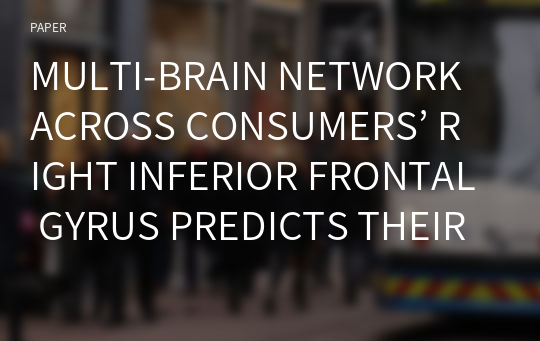MULTI-BRAIN NETWORK ACROSS CONSUMERS’ RIGHT INFERIOR FRONTAL GYRUS PREDICTS THEIR ATTITUDES TOWARD ADVERTISING
* 본 문서는 배포용으로 복사 및 편집이 불가합니다.
서지정보
ㆍ발행기관 : 글로벌지식마케팅경영학회(GFMC)
ㆍ수록지정보 : Global Marketing Conference
ㆍ저자명 : Tao Liu, Xingchen Liu
ㆍ저자명 : Tao Liu, Xingchen Liu
영어 초록
IntroductionHow to evaluate quality of advertising? Previous behavioral studies have mainly focused on subjective reports of survey and interview containing social and cognitive bias, or objective data of sell changes suffering huge temporal and monetary cost. Recently, increasing researchers have proposed that techniques of neuro-imaging could provide an objective and effective way to examine cognitive neural mechanisms underlying consumer behavior (referred to as consumer neuroscience) (Karmarkar & Yoon, 2016), and several studies have measured consumer's brain responses to advertising and movie trailer in both single- and two-brain frames (Barnett & Cerf, 2017; Venkatraman et al., 2015). However, still little is known about cognitive neural mechanisms underlying comprehension of advertising. Functional near-infrared spectroscopy (fNIRS) is a non-invasive technique of brain-imaging measuring changes in the hemodynamic properties of human brain. Compared with fMRI and EEG, fNIRS is portable, has few physical constraints on participants with reasonable spatial and temporal resolution, and is tolerant to electromagnetic noise and motion artifact. Therefore, fNIRS is a suitable tool for research of human behavior in daily-life contexts (Liu et al., in press), which is a trends in neuroimaging (Hasson & Honey, 2012) and consumer neuroscience as weill.
Methods
To examine the neural responses to different quality of advertisings, in the present study we measured 14 undergraduate students' frontal activations while watching 20 advertisings in Study 1 and listening 30 music demos in Study 2 using a portable fNIRS device, and analyzed interpersonal neural network across all participants based on graph theory. Figure 1 shows positions of the fNIRS channels. Positions of the fNIRS channels were measured by a 3D magnetic digitizer. In a pilot study, another group of participants were recruited to score 30 advertisings from three dimensions: degree of liking, degree of willing to pay (WTP), and degree of understanding, and finally top-10 and bottom-10 scored adverting were remained for the final experiment in Study 1. Concerning the music demos used in Study 2, we selected the top-15 and bottow-15 ranking music in the ‘Billboard 2014 hot 100’. During the experiment, participants were asked to score their degree of liking and WTP to the advertising or the music immediately after each stimulus was displayed. After the experiment, they were also instructed to score and report their understanding on each advertising or music.
Results and Discussion
In Study 1, the intra-brain activations revealed higher medial prefrontal cortex (mPFC) activation when participants watched low-scored advertisings than watched high-scored ones (Fig. 2), and the mPFC activations showed a positive relationship with participants’ understanding on the meaning of the advertisings. This result only suggests that low-scored advertisings were relatively hard for participants to understand the intentions of the adverting, requiring more cognitive resources of mentalizing (Lieberman, 2007). Importantly, when we considered all participants' brains as a network, and then calculated the interpersonal neural connectivity (INS) across the network (defined as the number of participant pairs who showed significant positive inter-brain neural synchronization across them indicating shared understanding) (Hasson et al., 2012), only the network connectivity in the right inferior frontal gyrus (IFG) had significantly positive relationships with participants' scores of attitude towards the advertisings (defined as mean of the scores of liking and WTP) (Fig. 3). Study 2 confirmed the result showing significantly positive relationship between the network connectivity across all participants' brains and their scores of attitude towards the song demos. More importantly, the network connectivity in the right IFG of the small group of participants also significantly predicted the public's attitude towards the songs assessed by the rating scores on Douban website (Fig. 4).
Conclusion
The right IFG is a core area of mirror neuron system and is closely associated with empathy (Lamm et al., 2007). Thus, the present results suggest that high-scored advertisings may activate consumer's empathic response to simulate and experience their contents and intentions. And the network connectivity across consumers' brains in the right IFG may be a critical index evaluating quality of experiential advertisings. Practically, advertising should invite consumers to experience their products, and then could convey information and emotion more effectively.
참고 자료
없음"Global Marketing Conference"의 다른 논문
 THE ROLES OF GREEN PACKAGING IN UGLY FOOD PURCHASE INTE..22페이지
THE ROLES OF GREEN PACKAGING IN UGLY FOOD PURCHASE INTE..22페이지 THE IMPACT OF INDUCED AWE ON ETHICAL TOURIST BEHAVIORS5페이지
THE IMPACT OF INDUCED AWE ON ETHICAL TOURIST BEHAVIORS5페이지 A BIBLIOMETRIC ANALYSIS OF SPIRITUAL TOURISM RESEARCH15페이지
A BIBLIOMETRIC ANALYSIS OF SPIRITUAL TOURISM RESEARCH15페이지 SOCIAL NETWORK ANALYSIS AND RESPONSE TIME TESTING: CONS..11페이지
SOCIAL NETWORK ANALYSIS AND RESPONSE TIME TESTING: CONS..11페이지 THE EFFECTS OF PARA-SOCIAL INTERACTION ON ONLINE CELEBR..3페이지
THE EFFECTS OF PARA-SOCIAL INTERACTION ON ONLINE CELEBR..3페이지 THE INFLUENCE OF OPINION LEADERS ON DAILY DEALS USER’S ..3페이지
THE INFLUENCE OF OPINION LEADERS ON DAILY DEALS USER’S ..3페이지 HOW IMMERSIVE RETAILING AFFECTS CONSUMERS’ URGE TO BUY:..6페이지
HOW IMMERSIVE RETAILING AFFECTS CONSUMERS’ URGE TO BUY:..6페이지 KEY TO SUPERSTARDOM IN A GLOBALISED MARKET: THE ROLE OF..6페이지
KEY TO SUPERSTARDOM IN A GLOBALISED MARKET: THE ROLE OF..6페이지 A POST-PANDEMIC LOOK AT TOURISTS’ PERCEIVED COOLNESS OF..4페이지
A POST-PANDEMIC LOOK AT TOURISTS’ PERCEIVED COOLNESS OF..4페이지 EXTRACTING OFFLINE RETAIL SHOPPING PATTERNS: OLLABORATI..5페이지
EXTRACTING OFFLINE RETAIL SHOPPING PATTERNS: OLLABORATI..5페이지



























